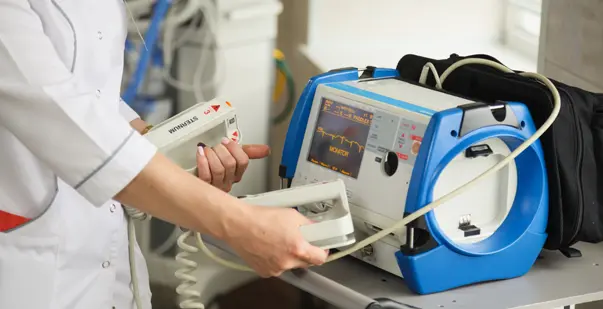Table of content(s)
- When is synchronized cardioversion used?
- How is synchronized cardioversion performed?
- What are the common premedication options for synchronized cardioversion?
- What are the key indicators for emergency synchronized cardioversion?
- What are the differences between synchronized and unsynchronized cardioversion?
- How does synchronized cardioversion help in treating atrial fibrillation?
Synchronized cardioversion is a procedure used to treat abnormal heart rhythms. It involves delivering an electrical shock to the chest to restore a normal heart rhythm. Synchronized cardioversion is used for unstable tachyarrhythmias, such as atrial fibrillation or ventricular tachycardia with a pulse.
The energy level of the shock is determined based on the specific rhythm being treated. Sedation is often given to the patient to minimize discomfort. After the procedure, the patient’s rhythm and vital signs are closely monitored. So, let us explore how synchronized cardioversion ACLS works, how it is performed, and the common premedication options.
Master ACLS Now
Get ACLS certified with confidence
When is synchronized cardioversion used?
During advanced cardiovascular life support, synchronized cardioversion is used in the following situations:
- Unstable tachyarrhythmias, such as atrial fibrillation or ventricular tachycardia with a pulse.
- Wide QRS complex tachycardia with evidence of hemodynamic instability.
- Patients with chest pain, dyspnea, altered mental status, hypotension, pulmonary edema, or ischemic changes on the ECG.
- Patients with sustained monomorphic ventricular tachycardia.
How is synchronized cardioversion performed?
Synchronized cardioversion is a medical procedure performed using a defibrillator machine that is synchronized with the patient’s ECG rhythm to deliver the shock at the peak of the QRS complex. Here are the steps to perform synchronized cardioversion in bullets:
- Prepare patient: Sedate and prepare for the procedure.
- Place electrodes: Attach electrodes or paddles to the chest.
- Synchronize: Press the “sync” button to synchronize with the ECG rhythm.
- Select energy: Choose the appropriate energy level for the patient.
- Deliver shock: Press the charge button to deliver shock.
- Monitor: Reassess rhythm and vital signs aftershock.
What are the common premedication options for synchronized cardioversion?
To ensure the patient’s safety during the procedure, premedication is administered to sedate and relax them. Here are some common premedication options used for synchronized cardioversion:
- Midazolam: A benzodiazepine that helps to sedate the patient and reduce anxiety.
- Diazepam: Another benzodiazepine that can be used to sedate the patient and reduce muscle spasms.
- Morphine: An opioid analgesic that can be used to manage pain and anxiety.
- Fentanyl: A synthetic opioid that can be used to manage pain and anxiety.
- Propofol: An intravenous anesthetic that can be used to induce sedation and anesthesia.
Read more: Cardiac Disease in the Young: Recognizing and Understanding Early Signs
What are the key indicators for emergency synchronized cardioversion?
Emergency synchronized cardioversion is indicated for patients with unstable cardiac arrhythmias that are causing symptoms and are not responding to medication. Here are the key indicators:
- Unstable atrial fibrillation
- Unstable atrial flutter
- Unstable supraventricular tachycardia
- Unstable ventricular tachycardia
- Rapid atrial fibrillation
What are the differences between synchronized and unsynchronized cardioversion?
Synchronized cardioversion and unsynchronized cardioversion are two different techniques used to restore a normal heart rhythm. Here are the key differences between them:
| Characteristic | Synchronized Cardioversion | Unsynchronized Cardioversion (Defibrillation) |
| Energy Level | Low energy shock | High energy shock |
| Timing | Delivered at the peak of the QRS complex | Delivered randomly within the cardiac cycle |
| Indications | Unstable atrial fibrillation, atrial flutter, atrial tachycardia, and supraventricular tachycardias | Pulseless ventricular tachycardia, ventricular fibrillation, and pulseless electrical activity |
| Risk of VF | Low risk of inducing ventricular fibrillation | High risk of inducing ventricular fibrillation |
| Use | Used in stable patients with a QRS complex | Used in unstable patients or those with no coordinated intrinsic electrical activity |
How does synchronized cardioversion help in treating atrial fibrillation?
Here’s how synchronized cardioversion helps in treating atrial fibrillation:
- Helps to restore the heart’s normal rhythm by delivering a controlled electrical shock.
- The shock is synchronized with the R wave of the patient’s EKG, ensuring that it is delivered at the optimal time.
- It interrupts the chaotic electrical signals in the atria and allows the heart’s natural pacemaker to regain control.
- Quickly converts atrial fibrillation to normal sinus rhythm.
- It is particularly effective for recent-onset or acute atrial fibrillation.
- Relieves symptoms such as palpitations, shortness of breath, and fatigue.
- It may be used when medications or other interventions have failed to restore normal rhythm.
- Performed as an outpatient procedure in a hospital or clinic setting.
- Generally safe and well-tolerated, with minimal risks and complications.
- Usually followed by the use of medications or other treatments to maintain normal rhythm.
Read more: Study Guide To Body Systems: ACLS Certification Resource
Conclusion
Cardioversion ACLS works by treating abnormal heart rhythms such as atrial fibrillation and ventricular tachycardia with a pulse. It involves delivering a controlled electrical shock at the correct time during the cardiac cycle to restore a normal heart rhythm. Synchronized cardioversion is effective in quickly converting atrial fibrillation to normal sinus rhythm and relieving symptoms. It can be performed as an outpatient procedure and is generally safe and well-tolerated.







